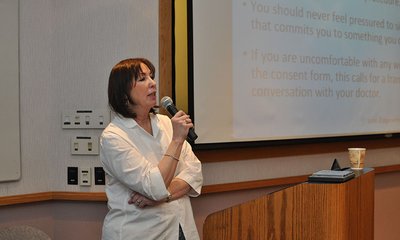Before her son Michael died in 2004, Patricia Skolnik made him a promise to make the medical field a safer place for patients.
Nearly three years before his death, Michael, then a practicing emergency medical technician and nursing student, experienced a sudden seizure at his parents’ house. The doctor at the hospital suggested the seizure was likely the side effect of his smoking cessation medicine. A CT scan revealed what was identified as a possible three-millimeter spot on his brain, which led a neurosurgeon to recommend that Michael have surgery right away.
No cyst or tumor was ever found during the surgery, Skolnik noted. And that “unnecessary” surgery marked the beginning of her son’s decline—including debilitating health problems and unnecessary suffering — before his death, she said.
“There was no rush to go into that surgery,” Skolnik said. “But we didn’t know that then, and we didn’t even know what to ask. We thought, ‘Who are we to question the doctor?’”
In fact, physicians reviewing Michael’s case after he died found that he had consented to the initial surgery while on drugs that could have impaired his understanding. At the time, the option of not having the surgery never even came up, said Skolnick. Nor did the surgeon discuss the risks of the surgery or invite the family to communicate their concerns.

“Patients should never feel pressured,” said Skolnik about the informed consent process. “You don’t hand someone informed consent [paperwork] on the gurney; it should take place as early as possible.”
A year after Michael’s death, Skolnik made good on her promise to her son, founding Citizens for Patient Safety (CPS) to improve shared decision making between patients and providers. Educating medical students, residents, and practicing physicians about how to gain a truly informed consent when treating patients is a key part of CPS’s efforts. CPS workshops provide training to ensure the patient and doctor discuss the risks, benefits, and alternatives of the procedure as well as the option of no treatment at all. They also teach providers how to listen and make certain the patient understands what is happening before agreeing to the procedure.
“Informed consent is a process, not a signature on a piece of paper,” summed up Andrew Varney, MD, residency program director in the Department of Internal Medicine at Southern Illinois University (SIU) School of Medicine. “It’s about respecting and trusting patients to make their own choices.”
It has to be taught
While informed consent is often connected to surgery and other high-risk procedures, all types of medical decisions require a patient’s consent. Evidence is limited on the specific links between informed consent and patient outcomes, though research has found that effective patient-provider communication is associated with better outcomes for both doctor and patient.
Yet, studies show that serious gaps in obtaining patient consent persist. For example, a 2013 report from the Agency for Healthcare Research and Quality cited research showing that only 9 percent of more than 1,000 outpatient encounters studied contained all the elements of informed decision making. The most frequent physician oversight was not assessing the patient’s understanding of the information. The report also noted that reading levels for informed consent documents are often too high and that most patients can’t fully recall what they’ve consented to.
“When students see that permission slip, they think, ‘If I just get them to sign it, that’s informed consent.’ Students and trainees don’t always make the connection that the permission slip is just one component of gathering informed consent.”
Gretchen Diemer, MD
Thomas Jefferson University Sidney Kimmel Medical College
Among the many medical schools where Skolnik has presented is the University of Colorado (CU) School of Medicine at the Anschutz Medical Campus. She spoke there in 2016 at a patient safety film festival that screened a documentary about Michael’s life and death. Michael’s story is also part of an interprofessional education curriculum that all first-year medical and health professions students at CU Anschutz Medical Campus receive, according to Wendy Madigosky, MD, MSPH, an associate professor in the Department of Family Medicine and curriculum director for Foundations of Doctoring.
CU medical students learn about the concept of informed consent and its ethical framework in their first year and analyze case studies in interprofessional teams. The students then dig deeper into the issue later in their training, Madigosky said. “The broader concept of engaging with patients and seeing them as partners in their care is an attitude that needs to be developed over time.”
For example, in connection with their surgical rotation, CU medical students must identify and write about a case explicitly related to informed consent; their work is then reviewed by medical ethicists. And in a fourth-year course on preparing for residency, students meet in small groups divided up by medical specialty to learn about and practice discussing options with a patient, providing patients with decision-making support tools, and assessing a patient’s competency to give a consent that is truly informed, Madigosky said.
At SIU HealthCare in Illinois, Varney noted that faculty observe internal medicine residents in scenarios that are purposefully designed to test whether a resident can recognize a patient with limited capacities.
Engaging patients in decisions
At Thomas Jefferson University Sidney Kimmel Medical College in Philadelphia, Pa., informed consent is a centerpiece of a fourth-year capstone course to prepare students for residency. According to Gretchen Diemer, MD, associate professor and vice chair for education in the Department of Medicine, the course uses informed consent scenarios as a means to develop advanced communication skills in a broader sense.
“When students see that permission slip, they think, ‘If I just get them to sign it, that’s informed consent,’” said Diemer, also the college’s associate dean for graduate medical education and affiliations. “Students and trainees don’t always make the connection that the permission slip is just one component of gathering informed consent.”
First piloted in 2010 and mandatory as of 2014, the capstone course begins with two didactic lectures: one on health literacy and another on informed consent. The informed consent lesson specifically emphasizes a method called “teach-back” that involves having patients explain back the information they just received from a physician. Students later participate in two standardized patient scenarios—obtaining informed consent from a patient for a blood transfusion and getting consent from the family member of a patient who is in critical care and requires a central venous catheter. Afterward, the standardized patients provide feedback on whether students avoided medical jargon, discussed risks and benefits, and used the teach-back method.
Diemer noted that after four years of learning a completely new vocabulary and studying highly complex concepts, “it’s actually much harder than you think to turn all that off and talk like a normal person again.”
She added that in surveys of graduates six months after completing the course, many were regularly using the informed consent skills during their internships.
“We owe it to our patients to do this right”
At Henry Ford Health System in Detroit, Mich., all incoming residents take part in a communication skills curriculum that covers informed consent. The curriculum is part of the system’s overall efforts to improve quality and safety, said Eric Scher, MD, chair of the Department of Internal Medicine and vice president for medical education.
During the informed consent component, Henry Ford residents learn about avoiding medical jargon and employing the teach-back method. Later, they take part in standardized patient scenarios that are filmed for evaluation.
“They need to know how to start the conversation, end the conversation. And they need to understand the dynamic nature between those two points,” Scher said.
In a study on the curriculum published in 2011 in the Journal of Graduate Medical Education, residents consistently reported greater knowledge of all the communication skills taught, noting in particular that they would most likely use the informed consent skills on a daily basis.
“This [patient-provider communication] is a gap across the country, and it’s impacting patient care, safety, and service,” said Scher. “We owe it to our patients to do this right.”
